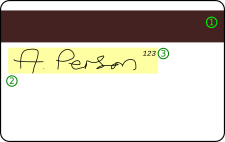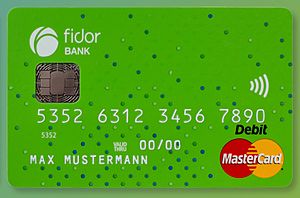Debit card facts for kids
A debit card is a plastic card used to pay for things. It's like a credit card, but with a big difference: a debit card uses money directly from your own bank account. If you don't have enough money in your account, the card won't work. Most debit cards are made of plastic, but some are metal or even wood.
Contents
How Debit Cards Started
The idea of bank cards began a long time ago. The very first bank cards were actually ATM cards. These were introduced by Barclays in London in 1967 and by Chemical Bank in New York in 1969.
In 1972, Lloyds Bank created the first bank card with a special magnetic stripe. This stripe held information and used a personal identification number (PIN) to keep your money safe. Later, in the 1970s, "smart cards" with computer chips were invented. These smart cards started being used for payments in the mid-1980s.
Different Kinds of Debit Cards
There are several big companies that run debit card networks, like UnionPay, American Express, Discover, Mastercard, and Visa. Other networks include STAR and JCB. Many types of debit cards only work in specific countries or regions.
Online Debit Cards
Some debit cards are called "online debit cards." When you use one, the bank checks your account right away to make sure you have enough money. This is called "electronic authorization." You often need to enter your PIN for these transactions. This makes them very secure, almost like an ATM card.
Online debit cards are generally safer than "offline" ones. This is because they check your account balance in real-time. This helps prevent problems with transactions that might take longer to process.
Keeping Your Money Safe
Debit card networks like Visa and MasterCard have rules to protect you. For example, stores usually can't set minimum or maximum amounts you have to spend with your card. They also can't add extra fees just for using your debit card.
In some places, like Singapore, debit cards might be turned off for international use by default. This helps prevent fraud and keeps your money safe. If you want to use your card when traveling, you usually need to turn on "international usage" first.
Who Uses Debit Cards?
Debit cards are very popular, especially among college students. They are a good way to manage money if you haven't built up a credit history yet. People who work in other countries, called expatriates, also use debit cards to send money back home to their families.
Buying Things Online
You can use debit cards to buy things on the internet. Sometimes you need to enter your PIN, and sometimes you don't. How the transaction works (whether it's "online" or "offline") depends on the store and your card. In some countries, it's common for online stores to accept only "online-only" cards, while in others, it's rare.
If a website has a secure way for you to enter your PIN, your online purchase can be processed like a regular debit transaction. Otherwise, it might be processed differently, but it still uses your own money from your bank account.
How Debit Cards Are Made
Debit cards follow special rules for their size, flexibility, and how information is stored on them. These rules are set by international organizations.
Embossing
Years ago, debit and credit cards had raised letters and numbers, which is called "embossing." This allowed stores to use a special machine to press the card's details onto a paper slip. This made processing payments faster and helped avoid mistakes. The embossed information usually included your card number, expiration date, and name.
Even though newer technologies like magnetic stripes and computer chips came along, cards were still embossed for a while. This was in case a store needed to process a payment manually. To check if you were the real cardholder, the store would ask you to sign the paper slip and then compare it to your signature on the back of the card.
Magnetic Stripe

Magnetic stripes started appearing on debit cards in the 1970s, around the same time ATMs became popular. This stripe holds all the information that's on the front of your card. When you swipe your card, a machine reads this data. This made payments much faster than the old manual way.
When you use a magnetic stripe card, you usually enter a PIN to prove you are the cardholder. This means you don't always need to sign a receipt anymore. Today, the magnetic stripe is slowly being replaced by the more advanced computer chip found on newer cards.
Images for kids
See also
- ATM card
- Credit card
- Electronic funds transfer
- Payment card
- Point-of-sale (POS)
- Card (disambiguation)
- Charge card
- Debit card cashback
- Electronic Payment Services
- EPAS
- Interac
- Inventory information approval system, a point-of-sale technology used with FSA debit cards
- Payments Council
- Payoneer
 In Spanish: Tarjeta de débito para niños
In Spanish: Tarjeta de débito para niños






